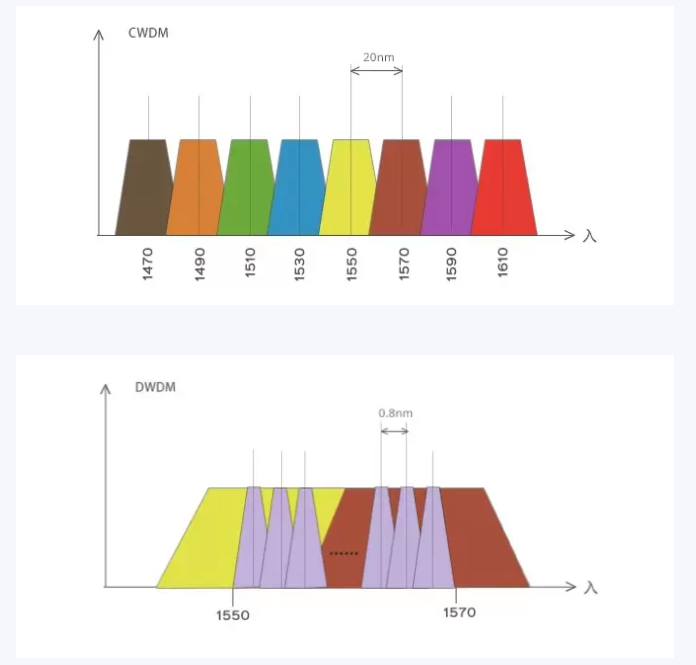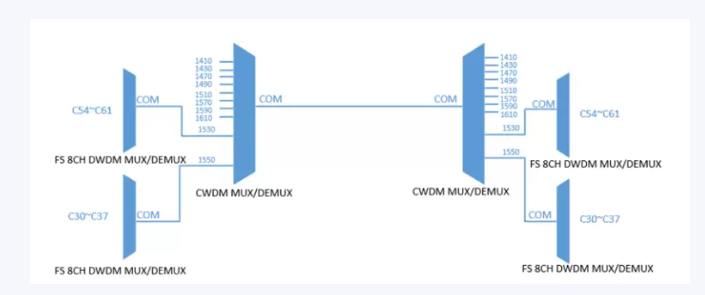

 Knowledge Base +
Knowledge Base +  2023.11.29
2023.11.29Wavelength division multiplexing (WDM) includes coarse wavelength division multiplexing (CWDM) and dense wavelength division multiplexing (DWDM). It refers to the simultaneous transmission of multiple signals of different wavelengths over a single fiber. The main purpose WDM is to increase the available bandwidth of the fiber and to expand capacity without laying additional fiber optic cables. Therefore, it is widely used by telecommunication companies.
What is the difference between CWDM and DWDM?
The wavelength interval is different:
Continuous Wavelength Division Multiplexing (CWDM): Wavelength spacing ≥ 20nm, usually using eight wavelength bands between 1470 and 1610nm with 20nm spacing.
DWDM: Wavelength spacing <10nm, usually using the wavelength range of 1550-1570nm, with wavelength spacing of 200GHz (1.6nm), 100GHz (0.8nm), 0r 50GHz (0.4nm).

Modulated lasers differ
Generally, for CWDM, uncooled laser diodes are used, while for DWDM, cooled laser diodes are used. Cooled laser diodes use temperature tuning, while uncooled laser diodes use electronic tuning.
Transmission Distance
Due to the high integration of Dense Wavelength Division Multiplexing (DWDM) devices, DWDM devices can transmit over longer distances than CWDM devices.
CWDM WDM devices are currently unable to transmit over unlimited distances and are limited to a maximum distance of 160 kilometers, whereas DWDM devices can transmit over much longer distances than CWDM devices.
Operation Cost
DWDM wavelength division multiplexing systems have uneven temperature distribution over a wide range of wavelengths, so the use of laser cooling technology to regulate temperature increases operating costs.
In addition, DWDM WDM systems typically cost four to five times more than CWDM WDM systems. However, with the popularity of DWDM, DWDM optical modules are now nearly 20-25% less expensive than CWDM optical modules.
>>> Read More:What is the difference between CWDM and DWDM SFP
What are the respective advantages of CWDM and DWDM?
The main advantage of a CWDM system over DWDM is the lower cost, with the main cost components being the filters and lasers. CWDM's wider 20nm wavelength spacing requires less stringent laser specifications and simplifies the structure of the optical multiplexer/demultiplexer, increasing throughput and reducing cost.
On the other hand, DWDM is suitable for long-distance transmission. Due to tighter wavelength spacing, DWDM can accommodate 8 to 160 wavelengths on a single fiber, making it more suitable for long-haul transmission. With the help of erbium-doped fiber amplifiers (EDFAs), DWDM systems can operate over thousands of kilometers.
What are the differences between CWDM and DWDM application scenarios?
CWDM and DWDM have different application scenarios due to their respective characteristics.
CWDM is used in short-distance communication scenarios such as metro access, telecom, enterprise network and campus network. It provides basic fiber optic network transmission and can meet general communication needs.
DWDM is applicable to long distance transmission, large capacity long distance network, or ultra-large capacity core node in MAN.
How to choose CWDM/DWDM?
Use of CWDM/DWDM
Due to the increasing demand for bandwidth, DWDM has made significant progress in reducing costs, making it increasingly popular in the market. However, CWDM still maintains a price advantage, especially in scenarios with sub-10G connection rates and short-distance transmission. In low-data network deployments, CWDM remains the most viable option.
Hybrid CWDM/DWDM Transmission
CWDM and DWDM devices have their own advantages in OTN networks. The advantage of CWDM equipment is its ability to utilize cost-effective uncooled distributed feedback lasers and inexpensive passive filters. This makes it widely used today in systems where cost is a key consideration compared to DWDM equipment.
While the use of CWDM technology in DWDM systems allows for the use of more cost-effective optical modules, the large channel spacing of CWDM results in a reduction in the number of wavelengths available in the system. This limitation somewhat restricts the transmission capacity of the system to that of non-hybrid DWDM equipment.

From the above analysis, it can be seen that in the future, CWDM and DWDM equipment will be complementary rather than alternative.
Additional Learning Hub Resources
What are the types and differences between fiber optic patch cords
What are the 4 common fiber optic connectors?
Fiber optic connector general troubleshooting methods introduced
What are the general types of optical fiber connectors? How to clean better?
Subscribe to the newsletter
for all the latest updates.
2-5# Building, Tongfuyu Industrial Zone, Aiqun Road, Shiyan Street, Baoan District, Shenzhen. China
